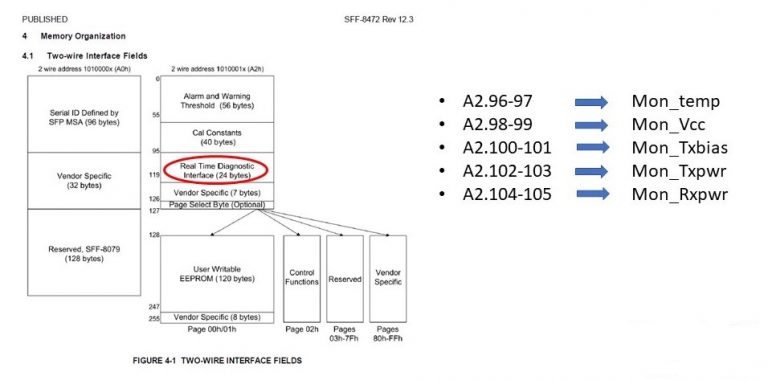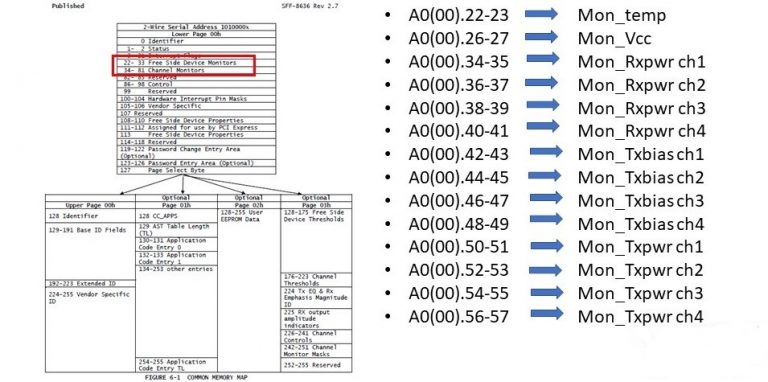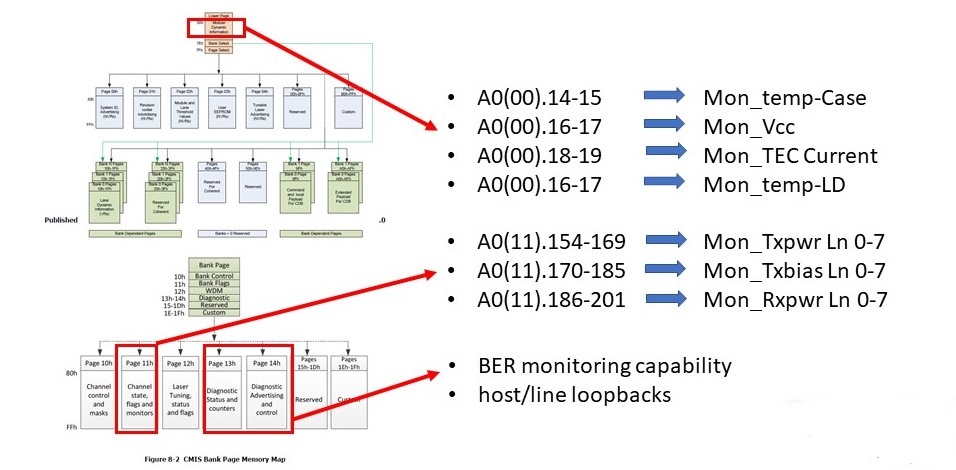What is DDM?
DDM stands for Digital Diagnostic Monitoring according to the industry standard MSA (Multi-Source Agreement). Most of the transceivers in use today feature the DDM function. Network engineers use DDM function to monitor optical transceiver performance in real time.
Latest MSA standards for digital monitoring of optical modules –
- SFP/SFP+ SFF-8472 Management Interface
- QSFP SFF-8636 Management Interface
- QSFP-DD CMIS
Important parameters to monitor
DDM enables users to monitor parameters that help them to operate the transceiver more effectively. These five basic parameters are common across all standards.
- Case Temperature: Mon_temp
- Supply Voltage: Mon_Vcc
- Receiver Input Power: Mon_Rxpwr
- Transmitter LD Bias Current: Mon_Txbias
- Transmitter Output Power: Mon_Txpwr
Where are the DDMIs?
SFP/SFP+ (SFF-8472)
This image shows the memory map defined in the SFF-8472. SFF-8472 uses 1010001X (A2h) to provide diagnostic information about the module’s operating conditions.

The red circle shows you where you can find these monitors. The address is A2, which is page 0, then pages 1, 2 etc. and all the way to page 80h or FFh. Most of them are internal vendor tables. The EEPROM for a 10G SFP+ is in 2 pages.
Each monitor takes up 2 bytes.
QSFP (SFF-8636)
Image below shows the memory map defined in SFF-8636. The red circle shows the location of the monitors.

Case temperature and Supply voltage are common for the module whereas the other parameters, (Receiver input power, Transmitter bias current and Transmitter output power) are for each lane.
QSFP-DD (CMIS 4.0)
CMIS 4.0 is a powerful and robust EEPROM standard that emerged from the complex requirements of 400G optical modules. This standard defines host-to-module interactions, ensuring that modules are initialized and consistently run through the management interface.
The image below shows the memory map defined in CMIS 4.0.

The first four monitors (Case temperature, Supply Voltage, TEC Current and Laser Temperature) are in the first page or lower memory. Of this TEC Current and Laser Temperature are optional parameters in that some manufacturers choose to display them and some don’t.
Page 11 displays the other monitors – transceiver power, transceiver bias and receiver power.
Page 13 and 14 are where CMIS 4.0 capabilities really shine through. Page 14 shows the BER (Bit Error Rate) on all 8 lanes. With CMIS 4.0 you have the ability to loop back and forth between host and module to troubleshoot transceiver.
What do the values mean?
- Mon_temp (Range = +/-128 oC max) 16-bit in increments of 1/256 oC
- =HEX2DEC(CONCATENATE(MSB,LSM))/256. example: 1C 08 = 28.03 oC
- Mon_Vcc (Range = 6.55V max) 16-bit in increament of 0.1mV
- =HEX2DEC(CONCATENATE(MSB,LSM))/(10^4). example: 7C 74 = 3.19V
- Mon_Txbias (Range = 131 mA max) 16-bit in increament of 2uA
- =HEX2DEC(CONCATENATE(MSB,LSM))/(500). example: 96 E1 = 77.25mA
- Mon_Txpwr (Range = -40/+8.2dBm max) 16-bit in increment of 0.1uW
- =10*LOG(HEX2DEC(CONCATENATE(MSB,LSM))/(10^4)). example: 2F E4 = 0.88dBm
- Mon_Rxpwr (Range = -40/+8.2dBm max) 16-bit in increment of 0.1uW
- =10*LOG(HEX2DEC(CONCATENATE(MSB,LSM))/(10^4)). example: 08 A0 = -6.56dBm
Typical vendor specifications for DDMI

Mon_temp tells you how warm the case is and if it is out of the specified range. Supply voltage is another important parameter. When there is a high current surge, supply voltage may fall below the operating range. It is a good practice to check this parameter especially when switches are populated with all 32 modules.
Mon_Bias & Mon_Txpwr together point to a laser’s health. For example, when the laser output power drops by half and the operating current doubles, it means that the laser is dying. Hence these two parameters are important indicators of transmitter health.
Mon_Txpwr & Mon_Rxpwr can be used together to check link loss. One thing to note here is that each of these values have a tolerance of +/3 dB which means that together it is +/-6dB. Here using absolute values will throw you off.
A good practice is to record these values from manufacturer reports or at the beginning of live data transmission so that later when you troubleshoot, you have these numbers to compare.
Vitex is a leading supplier of optical transceivers to telecom and data center industries. If you have any questions about transceivers or DDMI, email us at info@vitextech.com
Related Products

